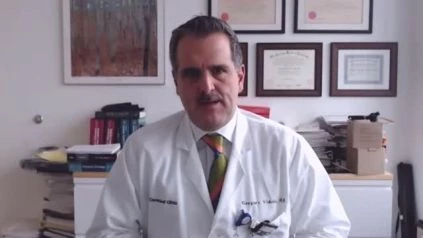Gregory M. Videtic MD, CM, FRCPC, FACR, FASTRO Section Head for Thoracic Malignancies and Residency Program Director in the Department of Radiation Oncology from the Cleveland Clinic explains the ASTRO 2020 Abstract 2192 Ten-Year Experience in Implementing Single-Fraction Lung SBRT for Medically Inoperable Early Stage Lung Cancer.
Link to the Poster –
https://astro.multilearning.com/astro/2020/annualmeeting/299139?evname=u42P5_6f3xRUr5o4erxthw&evsign=qHSlYUSOTWdeKOP7_nrA0o8Ly2HKhzA2gN9W3g-RXrk
BodyÂ
Purpose / Goal(s):
To study single-institution outcomes for medically inoperable peripheral early-stage lung cancer after ten years of single-fraction lung SBRT (SF-SBRT), prompted by the recent publication of randomized phase II trials in which this fractionation was evaluated.
Methods/Materials:
In 12/2009, our first SF-SBRT pt was treated (on RPCI124407). Therefore, for the 12/2009-12/2019 interval, we surveyed our IRB-approved prospective lung SBRT data registry for all pts receiving SF-SBRT on or off protocols, with a minimum follow-up of 6 months, and who were definitively treated for stage I disease or synchronous primaries. The SF-SBRT dose was either 34 or 30 Gy, with all cases scheduled according to the requirements for RTOG 0915 and RPCI124407, respectively. The outcomes of concern included local control (LC) and overall survival (OS) rates, as well as CTCAE version 4.0.0 graded treatment-related toxicity.
Outcomes:
229 (9.9 percent) of 2315 total cases met study requirements. Pt features included: female (55 percent); median age 74.6 years (range 47-94); median KPS 80 (range 50-100); active smokers 23.1 percent; median FEV1 pretreatment: 1.38L (range 0.34-4.16)/59 percent predicted (range 17-128); and DLCO 50 percent predicted (range 13-133), with inoperability in 52.4 percent of cases attributable to irregular pulmonary functions. Tumor characteristics included: median diameter 1.6 cm (range 0.7-4.1); stage T1a 64.6 percent; median PET SUVmax 6.1 (range 0.8-24.3); synchronous primary 4.8 percent; chest wall 28.8 percent. 63.6% of pts were biopsied and the findings were as follows: 42.2% adenocarcinoma, 31.2% squamous carcinoma, 12.3% “other” and 14.3% non-diagnostic. In 72.1 percent of cases, the SF-SBRT dose was 34 Gy and in 27.9 percent, 30 Gy, with pt and tumor characteristics matched between cohorts. The average median follow-up periods for 30 Gy and 34 Gy were respectively 36.7 and 17.2 months (p<0.0001), indicating different start dates of the study. 55.9% of pts were alive in the study. Grade 3 toxicities (chest wall; pleural effusion) were formed in two (0.9 percent) pts and no grade 4/5 toxicities. In 7% and 12.7% pts, respectively, grades 1-2 pneumonitis and chest wall toxicity were seen. The median overall survival was 44.1 months, with 73.8 percent overall 2-year survival. 7.28, 9.43, and 12.23 were rates (in percent) of 2-year local, nodal, and distant failure, respectively. No major variations were observed in outcomes by dosage.
The Conclusion:
A decade of SF-SBRT experience within a single organization for medically inoperable early peripheral lung cancer has resulted in findings comparable to reported results from two randomized trials and further encourages the use of this schedule in regular practice. Our institutional quality of treatment for this presentation of the disease has been SF-SBRT.

